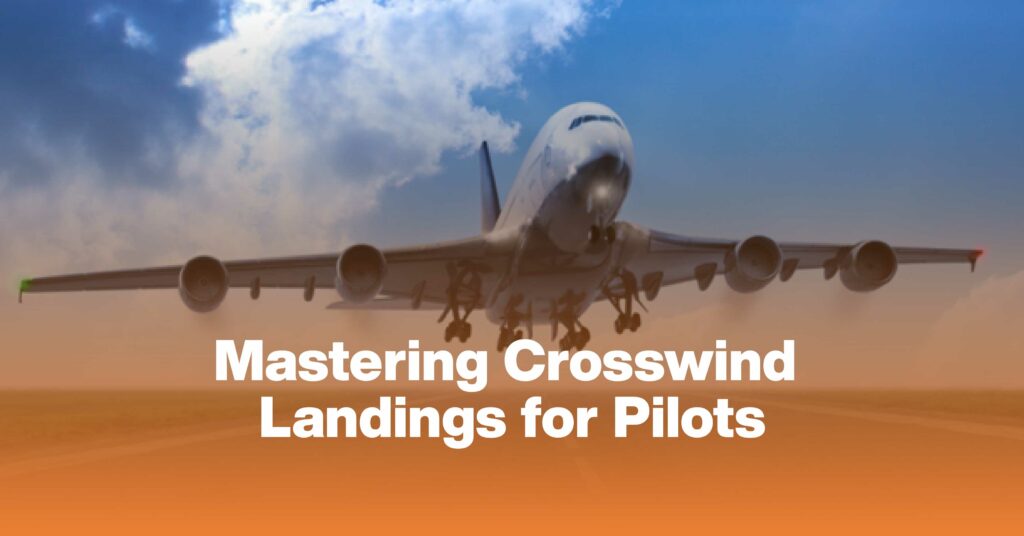Piloting an aircraft requires a wide range of skills and knowledge, and one of the most challenging aspects of flying is mastering crosswind landings. Crosswinds are prevalent on many runways, and learning how to handle them is crucial for every pilot’s safety and confidence. In this article, we will explore what crosswinds are, provide valuable tips for crosswind landings, discuss common mistakes to avoid, and offer techniques to help pilots practice and improve their crosswind landing skills.
What Are Crosswinds?
Crosswinds are horizontal winds that blow perpendicular to the runway’s direction, making the aircraft drift off its intended path during landing. These winds can be caused by various factors such as pressure gradients, weather systems, or terrain obstructions. Crosswinds can significantly affect an aircraft’s stability and control, making it essential for pilots to be prepared to handle them effectively.
Tips For Crosswind Landings
1. Stay Updated with Weather Reports:
Before a flight, it is crucial to obtain up-to-date weather reports, including wind direction and speed. This information will help you anticipate crosswind conditions and plan your approach accordingly.
2. Check Aircraft Limitations:
Each aircraft has its limitations when it comes to crosswind landings. Refer to the aircraft’s manual or consult with a certified flight instructor to determine the maximum crosswind component that is safe for your aircraft. Adhering to these limitations is vital for a smooth and controlled landing.
3. Understand Your Aircraft’s Handling Characteristics:
Different aircraft respond differently to crosswinds. Familiarize yourself with your aircraft’s handling characteristics, including its control inputs and behavior during crosswind conditions. This knowledge will allow you to make accurate adjustments during the landing.
4. Maintain a Slower Groundspeed:
During crosswind landings, it is advisable to maintain a slightly higher approach speed. This extra speed will provide you with better control and prevent the aircraft from stalling in gusty conditions.
5. Use the Crabbing Technique:
Crabbing is a common technique used during crosswind landings. By pointing the aircraft’s nose into the wind, you can counteract the drift caused by crosswinds. Just before touchdown, use rudder and aileron inputs to straighten the aircraft’s alignment with the runway.
Crosswind Landing Techniques
1. Slip Technique:
The slip technique involves intentionally banking the aircraft into the wind while using opposite rudder inputs to maintain the runway’s centerline. This technique allows the aircraft to maintain a straight path during the approach and landing.
2. Forward Slip Technique:
The forward slip technique involves using both rudder and aileron inputs to intentionally create a sideslip. This technique helps in correcting excessive height or speed during the approach, allowing for a smoother landing.
3. Side Slip Technique:
The side slip technique involves using rudder inputs to align the aircraft’s longitudinal axis with the runway while using aileron inputs to counteract the crosswind. This technique allows for a more controlled approach and landing.
Common Mistakes To Avoid
1. Overcorrection:
One common mistake pilots make during crosswind landings is overcorrecting for wind drift. It is essential to make smooth and gradual control inputs to maintain control of the aircraft.
2. Landing with Excessive Speed:
Landing with excessive speed can compromise the aircraft’s stability and extend the landing distance. Pilots should maintain a proper approach speed and adjust it accordingly based on the wind conditions.
3. Neglecting Proper Flare:
A smooth and controlled flare is crucial for a safe landing in crosswind conditions. Neglecting the proper flare technique can result in a hard landing or even a bounce, putting the aircraft at risk.
Frequently Asked Questions
1. Why are crosswind landings challenging for pilots?
Crosswind landings are challenging for pilots because they require precise control inputs and a deep understanding of the aircraft’s behavior in crosswind conditions. It can be a daunting task to maintain the aircraft’s alignment with the runway while countering wind drift.
2. What are the risks associated with crosswind landings?
The risks associated with crosswind landings include the possibility of runway excursion, loss of control during landing, and potential damage to the aircraft. Improper handling of crosswinds can lead to accidents and pose a threat to the safety of everyone on board.
3. How can pilots determine the strength and direction of crosswinds?
Pilots can determine the strength and direction of crosswinds by referring to weather reports, windsocks or indicators on the airport, or using onboard weather systems. Additionally, observing the movement of objects on the ground, such as trees or grass, can provide valuable visual cues for wind conditions.
4. How does crabbing work in crosswind landings?
Crabbing involves pointing the aircraft’s nose into the wind to offset the drift caused by crosswinds. By maintaining a crab angle during the approach, the aircraft remains aligned with the runway’s centerline. Just before touchdown, the pilot uses rudder and aileron inputs to align the aircraft’s longitudinal axis with the runway.
5. How can pilots practice and improve their crosswind landing skill?
Pilots can practice and improve their crosswind landing skills by seeking guidance from certified flight instructors, utilizing flight simulators with crosswind landing scenarios, and regularly practicing crosswind approaches and landings with proper supervision. Consistent practice and training are key to mastering crosswind landings.
Conclusion
Mastering crosswind landings is a crucial skill for pilots to ensure safe and controlled landings. By understanding the nature of crosswinds, following the tips and techniques provided, and avoiding common mistakes, pilots can enhance their abilities and confidence in handling crosswind conditions. With proper training and practice, pilots can navigate challenging crosswind scenarios with ease and maintain the highest level of safety in their flights.

